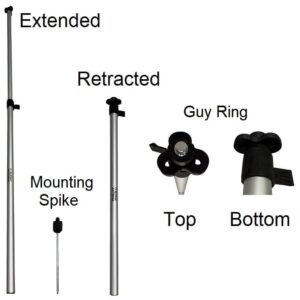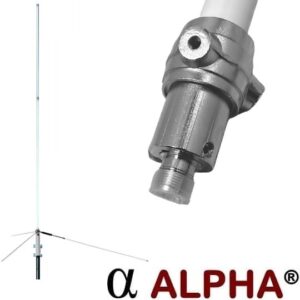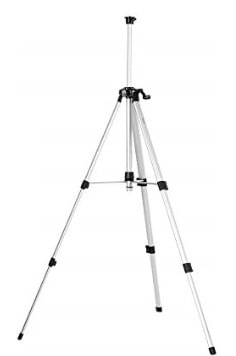When choosing the best VHF UHF antenna, first consider Range, Gain, and Mounting location.
How do you choose the best VHF UHF antenna?
Even the best radios in the world will not perform well if connected to the wrong VHF UHF antenna.
Increased Height equals Increased Range
In most cases, communicating by way of VHF or UHF is limited to about 20-55 miles, which is very dependent upon the mounting height of the VHF UHF antennas. The higher your antenna is, the greater the distance you’ll achieve. VHF and UHF radio waves travel pretty much in straight lines and your communications range will often be referred to as ‘line-of-sight’. Greatest distance is achieved when there is a clear unobstructed path between the two antennas that are used to establish communication between stations.
This is why our Base HF Antennas and VHF UHF Antennas, Portable HF Antennas and VHF UHF Antennas, or Mobile HF Antennas and VHF UHF Antennas VHF UHF Antennas work best when the areas around the antennas are not obstructed.
VHF UHF Antenna Gain
At its’ most basic level, the longer the VHF or UHF boom is, the higher the gain. Antenna gain refers to how the antenna is designed to increase the transmitted or received signal strength. If you wish to communicate in all directions, which is to say a full 360 degrees or in an omni-directional pattern, then a vertical VHF UHF Antenna is what you should use. Generally speaking, a higher gain antenna will provide a signal pattern that does not put your signal higher into the air, but it will instead provide a flatter pattern away from the antenna.
The flatter pattern is suitable for most installations. If, however, you are on the ocean in a boat then you will often be pitching and rolling on the waves. So, your very flat compressed signal will then also be pitching & rolling. This is not helpful for maintaining reliable communications, as signals will be lost with the motion of the boat. In this scenario, gain would need to be 0dBd so that the signal pattern is broad enough to account for the pitching and rolling of the VHF or UHF antenna itself.
In nearly all other scenarios, the antenna can have a gain of 3dBd or more. A little science literally ‘goes a long way’ when considering what VHF or UHF antenna to use. Look at the dBd or dBi and not the marketing hype of the other gain acronyms. Then realize, that 2.1 dBi equals 0dBd. Scientifically, 0dBd is the gain of a real dipole, which is why that measurement is used as the baseline for all gain figures. So, because VHF and UHF antennas work due to the principles of physics & radio wavelengths, you will generally find these antennas in 4 common lengths:
- Shortened VHF UHF antennas that are up to 50 centimeters long = -3dBd
- 1/2-wave (dipole) antennas that are approximately 1 meter long = 0dBd
- Colinear antennas that are approximately 2.5 meters long = 3dBd
- Colinear high-gain antennas that are approximately 5 or more meters long = 5-6 or more dBd
You can thus most often determine the antenna that has the higher gain by simply by checking the length of each antenna.
Mounting the VHF UHF Antenna(s)
How you attach your antenna to your boat depends on the features of mounting location. The two most common mounting methods are:
- Mast Mounting: Either a vertical mast or a horizontal mast, which most often is a rail on a boat or balcony, provides an ideal mounting location for a variety of very popular mounting options.
- Surface Mounting: You can mount the antenna on either a vertical or horizontal surface. If, however, the surface is horizontal, then you will want to ensure that the selected mount has a 90-degree bend so that the antenna is positioned vertically.
Physical environmental impact on performance
The physical environment that surrounds antennas will have an impact on performance. Here are the top things to consider about your environment when installing a VHF or UHF antenna. Mount the antenna(s):
- at least 3 feet away from other electronics or antennas,
- as high as possible, and
- as far away from metal objects, especially those that may run parallel to the antenna(s).
What else is important?
Selecting the right jacket for your coax, especially if your installations is near salt-water for example, can be very impactful to maintain the physical integrity of your VHF UHF Antenna system over time. The same can be said for the connectors that are chosen. The length of that same coax can also impact the performance, simply because you lose gain as the coax becomes longer.
Hiring a professional and reputable antenna company like Alpha Antenna should be your first priority. We are here to serve, and design then build your antenna system. So, please feel free to reach out to us for any questions you may have or for assistance designing your next VHF UHF antenna system.
See more Technical Articles
VHF UHF ANTENNA SELECTIONS
-
5 Foot Telescopic Mast$99.00
-
Sale Product on saleVHF UHF 6M Quad-band Antenna (UV6)
$169.00Original price was: $169.00.$129.00Current price is: $129.00.Rated 5.00 out of 5 based on 8 customer ratings -
(Medium Duty) MD-Tripod$119.00Rated 4.86 out of 5 based on 7 customer ratings




